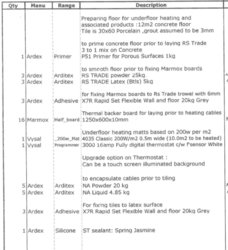d4vinder
TF
Hey guys, first time poster so be kind!
I had some porcelain tiles fitted in 2012, in the conservatory with underfloor heating. The same tiles have been laid throughout the ground floor of the property.
Recently, myself and my wife noticed a hollow sound when our daughter threw a tennis ball across the living area (open plan) through to the conservatory, we noticed a definite difference in the sound of the bounce when it got towards the conservatory. Typically the floor in that area has always been solid and this was new.
Upon recalling the tiler, he confirmed after lifting one or two of the tiles, that the tiles were pressured inwards and thus causing them to bow upwards. He first reaction was "that's, there's ground movement" - the reality is there has been no noticeable ground movement in the building outside of the norm, ie. there really hasn't been any that isn't usually tolerable as there are no cracks or signs of substance anywhere.
Upon lifting the few tiles to relive the bowing pressure, the cracking in the adhesive seems to be fairly consistent throughout. The tiler informed me that the process used to lay the tiles (which we luckily photographed at the time in 2012) shows the professional approach our tiler used to ensure the ground work for the UFH, boards and leveller all went on in accordance with the UFH mesh used then adhesive applied on top. Upon initial fitting, we adhered to the guidance of not switching it on for the first few weeks whilst it was still setting, it was switched on during the installation to ensure power and the heating mesh was working as expected. In summery, the Tiles are loose from the adhesive, but the boards are solid to the ground with no give unless you take a hammer to it. The adhesive is brittle and loose and comes away easily.
Below are some pictures that show the cracking in the adhesive. The tile came away quite easily from the centre of the conservatory-room where the main hollowness and bowing seems to be apparent. The few images after show how the tiles were laid with the UFH at the time.
I'm just an average consumer, any help in this situation would be very appreciated. Any feedback from the images would be great, the ones that show the laying process are ones from 2012 and the ones that show the cracking are from last month.
Loose Tiles:
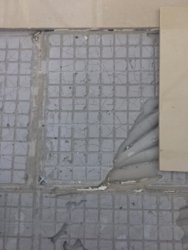
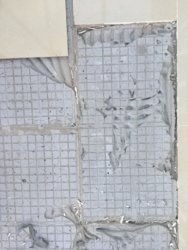
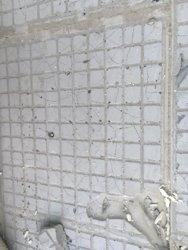
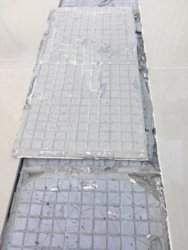




Laying Process
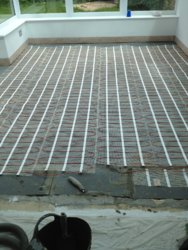
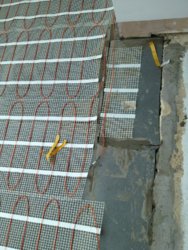
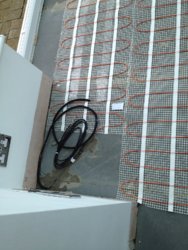
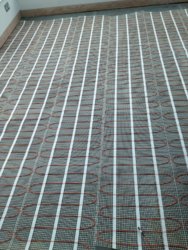
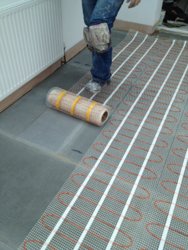
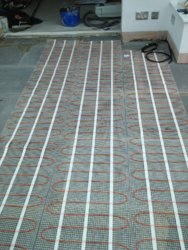
I had some porcelain tiles fitted in 2012, in the conservatory with underfloor heating. The same tiles have been laid throughout the ground floor of the property.
Recently, myself and my wife noticed a hollow sound when our daughter threw a tennis ball across the living area (open plan) through to the conservatory, we noticed a definite difference in the sound of the bounce when it got towards the conservatory. Typically the floor in that area has always been solid and this was new.
Upon recalling the tiler, he confirmed after lifting one or two of the tiles, that the tiles were pressured inwards and thus causing them to bow upwards. He first reaction was "that's, there's ground movement" - the reality is there has been no noticeable ground movement in the building outside of the norm, ie. there really hasn't been any that isn't usually tolerable as there are no cracks or signs of substance anywhere.
Upon lifting the few tiles to relive the bowing pressure, the cracking in the adhesive seems to be fairly consistent throughout. The tiler informed me that the process used to lay the tiles (which we luckily photographed at the time in 2012) shows the professional approach our tiler used to ensure the ground work for the UFH, boards and leveller all went on in accordance with the UFH mesh used then adhesive applied on top. Upon initial fitting, we adhered to the guidance of not switching it on for the first few weeks whilst it was still setting, it was switched on during the installation to ensure power and the heating mesh was working as expected. In summery, the Tiles are loose from the adhesive, but the boards are solid to the ground with no give unless you take a hammer to it. The adhesive is brittle and loose and comes away easily.
Below are some pictures that show the cracking in the adhesive. The tile came away quite easily from the centre of the conservatory-room where the main hollowness and bowing seems to be apparent. The few images after show how the tiles were laid with the UFH at the time.
I'm just an average consumer, any help in this situation would be very appreciated. Any feedback from the images would be great, the ones that show the laying process are ones from 2012 and the ones that show the cracking are from last month.
Loose Tiles:








Laying Process








